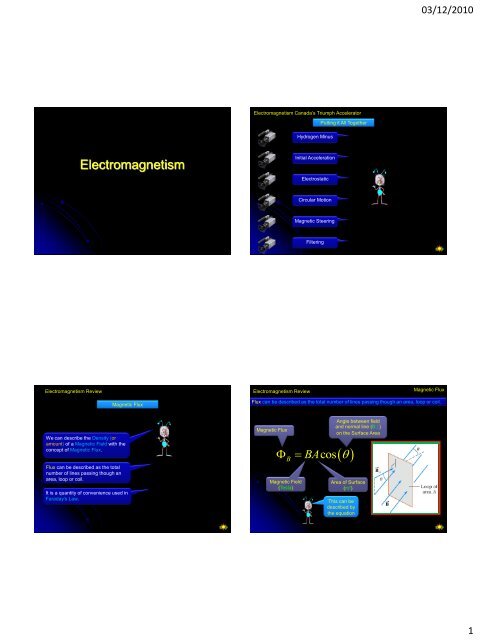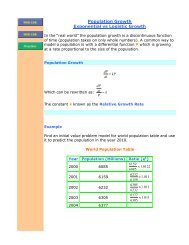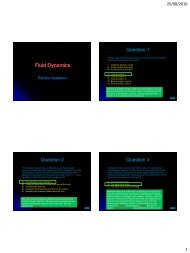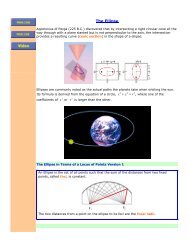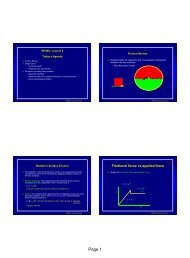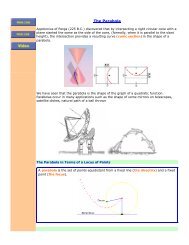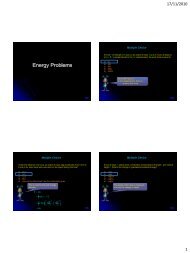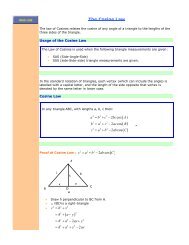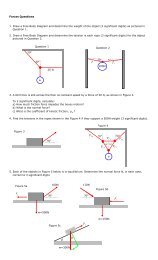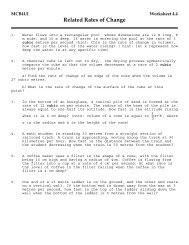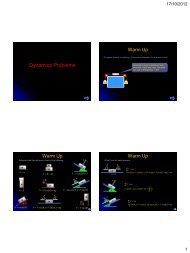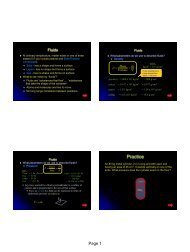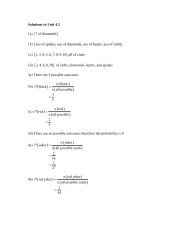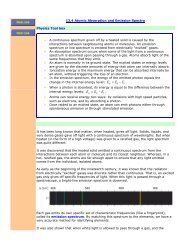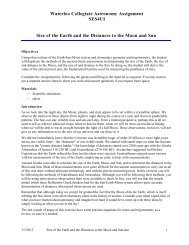Electromagnetism - The Burns Home Page
Electromagnetism - The Burns Home Page
Electromagnetism - The Burns Home Page
Create successful ePaper yourself
Turn your PDF publications into a flip-book with our unique Google optimized e-Paper software.
03/12/2010<br />
<strong>Electromagnetism</strong> Canada’s Triumph Accelerator<br />
Putting it All Together<br />
Hydrogen Minus<br />
<strong>Electromagnetism</strong><br />
Initial Acceleration<br />
Electrostatic<br />
Circular Motion<br />
Magnetic Steering<br />
Filtering<br />
<strong>Electromagnetism</strong> Review<br />
<strong>Electromagnetism</strong> Review<br />
Magnetic Flux<br />
Magnetic Flux<br />
Flux can be described as the total number of lines passing though an area, loop or coil.<br />
We can describe the Density (or<br />
amount) of a Magnetic Field with the<br />
concept of Magnetic Flux.<br />
Flux can be described as the total<br />
number of lines passing though an<br />
area, loop or coil.<br />
It is a quantity of convenience used in<br />
Faraday’s Law.<br />
Magnetic Flux<br />
B BAcos<br />
<br />
Magnetic Field<br />
(Tesla)<br />
Angle between field<br />
and normal line (B)<br />
on the Surface Area<br />
Area of Surface<br />
(m 2 )<br />
This can be<br />
described by<br />
the equation<br />
1
03/12/2010<br />
<strong>Electromagnetism</strong> Review<br />
B BAcos<br />
<br />
Magnetic Flux Observations<br />
<strong>Electromagnetism</strong> Review<br />
Magnetic Flux Units<br />
<strong>The</strong> Stronger the Magnetic Field (B),<br />
the greater the Flux ().<br />
Since<br />
B = BAcos(θ)<br />
Flux has the<br />
units of B x A<br />
<strong>The</strong> larger the Area (A), the greater<br />
the Flux ().<br />
This is also called<br />
a Weber (Wb)<br />
This is<br />
(Tesla)(Metre 2 )<br />
If the Magnetic Field (B) is<br />
perpendicular to the area, then the<br />
Flux () will be at a maximum.<br />
<strong>Electromagnetism</strong> Review<br />
Magnetic Flux Units<br />
<strong>Electromagnetism</strong> Review<br />
Magnetic Flux by Larger Area<br />
When the field is perpendicular<br />
to the plane of the loop<br />
θ = 0 and Φ B = Φ B, max = BA<br />
When the field is parallel to the<br />
plane of the loop.<br />
θ = 90° and Φ B = 0<br />
<strong>The</strong> flux can be negative, for<br />
example if θ = 180°<br />
When the field is at an angle θ to<br />
the field B, Φ B is less than<br />
max.<br />
You can increase the<br />
magnetic Flux by<br />
increasing the<br />
Surface Area<br />
2
03/12/2010<br />
<strong>Electromagnetism</strong> Review<br />
Magnetic Flux by Strengthening the Field<br />
<strong>Electromagnetism</strong> Review<br />
Magnetic Flux Practice Question<br />
B BAcos<br />
<br />
You have a hula loop of radius 0.5m that is immersed<br />
in the Earth’s magnetic field (5x10 -5 T). <strong>The</strong> hula loop<br />
is oriented in such a way that the normal is tilted at an<br />
angle of 20 0 away from the Earth’s North pole. What is<br />
the flux through the hoop?<br />
B BAcos<br />
<br />
B<br />
<br />
<br />
B r 2 cos<br />
You can increase the<br />
magnetic Flux by<br />
Strengthening the Field.<br />
.5 20<br />
<br />
<br />
B 5 10 T 0 m cos<br />
5<br />
3.710<br />
Wb<br />
B<br />
5 2<br />
<strong>Electromagnetism</strong> Review<br />
Faraday’s Law<br />
<strong>Electromagnetism</strong> Review<br />
Faraday’s Law<br />
Induction<br />
Law of Induction<br />
Faraday’s Law describes the<br />
relationship between Electric Current<br />
and Magnetism.<br />
An Electric Current can induce a<br />
Magnetic Field, and a Magnetic Field<br />
can induce a Electric Current.<br />
Induced Voltage, V.<br />
A voltage is generated a Magnetic<br />
Force has been traditionally called<br />
an Electromotive Force or emf.<br />
<strong>The</strong> number of coils<br />
of wire<br />
<br />
N<br />
t<br />
Change in Magnetic<br />
Flux, Wb<br />
Change in time, s<br />
Just as Electricity needs to be moving<br />
to create a Magnetic field B, <strong>The</strong><br />
Magnetic field B needs to be moving<br />
to create an Electric Current .<br />
•<strong>The</strong> greater the change in Magnetic Flux in a wire loop, the<br />
greater the Induced Current.<br />
•Less time corresponds to a greater Induced Current.<br />
•Adding more loops corresponds to a greater Induced Current.<br />
3
03/12/2010<br />
<strong>Electromagnetism</strong> Review<br />
<br />
N<br />
t<br />
Faraday’s Law Practice Question<br />
<strong>Electromagnetism</strong> Review<br />
B Direction<br />
Lenz’s Law<br />
You have a coil of wire with 30 loops, each of which has<br />
an area of 2.0 x 10 -3 m 2 . <strong>The</strong> Magnetic Field B is<br />
perpendicular to the surface. At time t=0 s, the Field B is<br />
measured at 1.0 T. At time, t=.2 s, the Field B is measured<br />
at 1.1 T. What is the average emf inside the coils.<br />
Lenz’s Law describes the direction of<br />
the Electric Current produced by a<br />
changing Magnetic Field.<br />
<br />
N<br />
t<br />
BAcos<br />
<br />
N<br />
t<br />
<br />
0.03V<br />
B BAcos<br />
<br />
1.1 1.0 2.0 10 3 2<br />
T T m cos 0<br />
<br />
30<br />
0.2s<br />
0.0s<br />
<strong>The</strong> Thumb points in the direction of<br />
the Current. <strong>The</strong> fingers curl in the<br />
direction of the Magnetic Field.<br />
<strong>Electromagnetism</strong> Review<br />
Lenz’s Law<br />
<strong>Electromagnetism</strong> Review<br />
Lenz’s Law<br />
B Direction<br />
Change in Flux<br />
An influenced emf gives rise to a<br />
Electric Current whose Magnetic Field<br />
opposes the original change in Flux.<br />
<strong>The</strong> Right Hand Rule can aid us in<br />
these situations.<br />
X X X X X X X<br />
X X X X X X X<br />
X X X X X X X<br />
X X X X X X X<br />
X X X X X X X<br />
X X X X X X X<br />
X X X X X X X<br />
X X X X X X X<br />
X X X X X X X<br />
X X X X X X X<br />
X X X X X X X<br />
X X X X X X X<br />
X X X X X X X<br />
X X X X X X X<br />
Notice how the area is lessened when the loop is stretched.<br />
Since the Flux is reduced, the Electric Current flows in the<br />
direction that would produce the B field. This direction tries<br />
to help maintain the original Flux.<br />
<strong>The</strong> induced current attempts to maintain the status quo.<br />
4
N<br />
S<br />
03/12/2010<br />
<strong>Electromagnetism</strong> Review<br />
Lenz’s Law<br />
<strong>Electromagnetism</strong> Review<br />
Lenz’s Law<br />
Hoop Entering B Field<br />
Hoop Inside B Field<br />
X X X X X X X<br />
X X X X X X X<br />
X X X X X X X<br />
X X X X X X X<br />
X X X X X X X<br />
X X X X X X X<br />
X X X X X X X<br />
X X X X X X X<br />
X X X X X X X<br />
X X X X X X X<br />
X X X X X X X<br />
X X X X X X X<br />
X X X X X X X<br />
X X X X X X X<br />
When the loop enters a Magnetic<br />
Field. An Electric Current is induced<br />
(counter clockwise) in the loop as to<br />
oppose the increase in the Flux inside<br />
the loop.<br />
When the loop is total immersed<br />
inside a Magnetic Field there is No<br />
increase in Flux therefore there is No<br />
Current flow in the loop.<br />
<strong>Electromagnetism</strong> Review<br />
Lenz’s Law<br />
<strong>Electromagnetism</strong> Review<br />
Lenz’s Law<br />
Hoop Exiting B Field<br />
Magnet Moving Through Hoop<br />
X X X X X X X<br />
X X X X X X X<br />
X X X X X X X<br />
X X X X X X X<br />
X X X X X X X<br />
X X X X X X X<br />
X X X X X X X<br />
When the loop exits a Magnetic Field.<br />
An Electric Current is induced<br />
(clockwise) in the loop as to oppose<br />
the decrease in the Flux inside the<br />
loop.<br />
When a magnet enters the<br />
loop passes the through current will flow<br />
clockwise a closed loop, (to oppose the<br />
increase the current in flux, will make the<br />
end flow of in the what loop the magnet<br />
enters directions? act like a North<br />
Pole) then zero. As the<br />
magnet exits, the current<br />
will then flow counter<br />
clockwise (to oppose the<br />
decrease in flux, ie look<br />
like a South Pole).<br />
5
03/12/2010<br />
<strong>Electromagnetism</strong> Review<br />
Lenz’s Law<br />
<strong>Electromagnetism</strong> Review<br />
EMF<br />
Magnet Moving Through Hoop<br />
EMF induced in a Moving<br />
Conductor<br />
When the North end of a<br />
<strong>The</strong> magnet current enters will the flow loop clockwise from<br />
to behind oppose the the screen, increasing which flux.<br />
direction, if any, will the<br />
current flow in the wire?<br />
We have a conducting bar moving across<br />
a U shaped wire. <strong>The</strong> magnetic field is<br />
coming out of the screen. As the bar<br />
moves across the wire, the amount of Flux<br />
inside the loop increases.<br />
<strong>Electromagnetism</strong> Review<br />
Faraday’s Law<br />
<strong>Electromagnetism</strong> Review<br />
EMF<br />
EMF in a Moving Conductor<br />
EMF induced in a Moving Conductor<br />
Induced Electromotive Force or emf.<br />
Velocity in m/s.<br />
A 2.0 m rod is moving at 7 m/s perpendicular<br />
to a 1.2 T magnetic field heading into the<br />
screen. Determine the induced emf.<br />
BLv<br />
Magnetic Field in T.<br />
Length of moving<br />
conductor in m.<br />
X X X X X X X X X X X<br />
X X X X X X X X X X X<br />
X X X X X X X X X X X<br />
X X X X X X X X X X X<br />
X X X X X X X X X X X<br />
6
03/12/2010<br />
<strong>Electromagnetism</strong> Review<br />
EMF<br />
<strong>Electromagnetism</strong> Review<br />
Recall<br />
EMF induced in a Moving Conductor<br />
Force of Magnetic Field on Current<br />
BLv<br />
m <br />
1.2T 2.0m7<br />
<br />
s <br />
17V<br />
X X X X X X X X X X X<br />
X X X X X X X X X X X<br />
X X X X X X X X X X X<br />
X X X X X X X X X X X<br />
X X X X X X X X X X X<br />
• Force on 1 moving charge:<br />
‣ F = q v B sin()<br />
‣ Out of the page (RHR)<br />
• Force on many moving charges:<br />
‣ F = (q/t)(vt)B sin()<br />
= I L B sin()<br />
+<br />
‣Out of the page!<br />
+<br />
<br />
v<br />
+ + +<br />
v<br />
L = vt<br />
B<br />
I = q/t<br />
distance<br />
Torque on Current Loop in B field<br />
W<br />
d<br />
a<br />
• F<br />
L<br />
Force on sections B-C and A-D: F = IBW<br />
Torque on loop is t = L F sin(f) = ILWB sin(f)<br />
Torque is<br />
I<br />
(length x width = area)<br />
c<br />
F<br />
X<br />
b<br />
B<br />
t = I A B sin(f)<br />
LW = A<br />
F<br />
d<br />
f<br />
a<br />
b<br />
c<br />
F<br />
Understanding: Torque on<br />
Current Loop<br />
What is the torque on the loop below?<br />
1<br />
2<br />
3<br />
t < IAB<br />
t = IAB<br />
t > IAB<br />
t = 0<br />
x x x x x x x x x x x x x x x x<br />
x x x x x x x x x x x x x x x x<br />
x x x x x x x x x x x x x x x x<br />
x x x x x x x x x x x x x x x x<br />
x x x x x x x x x x x x x x x x<br />
x x x x x x x x x x x x x x x x<br />
x x x x x x x x x x x x x x x x<br />
x x x x x x x x x x x x x x x x<br />
7
03/12/2010<br />
Torque on Current Loop<br />
Understanding: Torque<br />
Magnitude:<br />
t = I A B sinf<br />
F<br />
f<br />
B<br />
B<br />
B<br />
Direction:<br />
Torque tries to line up the normal with B!<br />
(when normal lines up with B, f=0, so t=0! )<br />
Even if the loop is not rectangular, as long as it is flat:<br />
# of<br />
loops<br />
between normal and B<br />
t = N I A B sinf.<br />
(area of<br />
loop)<br />
F<br />
I<br />
(1)<br />
Compare the torque on loop 1 and 2 which have<br />
identical area, and current.<br />
Area points out<br />
of page for both!<br />
1) t 1 > t 2 2) t 1 = t 2 3) t 1 < t 2<br />
t = I A B sinf<br />
(2)<br />
f = 90 degrees<br />
B<br />
B<br />
-<br />
+<br />
+ v<br />
F<br />
L<br />
-<br />
+<br />
Motional EMF<br />
Moving + charge feels force downwards:<br />
v<br />
F = q v B sin()<br />
Velocity<br />
Moving + charge still feels force downwards:<br />
Potential Difference F d/q<br />
EMF = q v B sin() L/q<br />
= v B L<br />
Angle between<br />
v and B<br />
Understanding<br />
• Which bar has the<br />
larger motional emf? a b<br />
ε = v B L sin()<br />
is angle between v and B<br />
Case a: = 0, so ε = 0<br />
Case b: = 90, so ε = v B L<br />
v<br />
“a is parallel, b is perpendicular”<br />
v<br />
Velocity<br />
8
03/12/2010<br />
Motional EMF circuit<br />
Moving bar acts like battery = vBL<br />
• Magnitude of current<br />
I = /R = vBL/R<br />
• Direction of Current<br />
Clockwise (+ charges go down thru bar, up thru bulb)<br />
• Direction of force (F=ILB sin()) on bar due to<br />
magnetic field<br />
What changes if B<br />
points into page?<br />
To left, slows down<br />
B<br />
-<br />
+<br />
V<br />
Motional EMF circuit<br />
Moving bar acts like battery = vBL<br />
• Magnitude of current<br />
I = /R = vBL/R<br />
• Direction of Current<br />
Still to left, slows down<br />
B<br />
x x x x x x x x x x x x x x x x x<br />
x x x x x x x x x x x x x x x x x<br />
V<br />
+<br />
x x x x x x x x x x x x x x x x x<br />
-<br />
x x x x x x x x x x x x x x x x x<br />
x x x x x x x x x x x x x x x x x<br />
Counter-Clockwise (+ charges go up thru bar, down thru bulb)<br />
• Direction of force (F=ILB sin()) on bar due to<br />
magnetic field<br />
Understanding<br />
Suppose the magnetic<br />
field is reversed so that it<br />
now points OUT of the<br />
page instead of IN as<br />
shown in the figure.<br />
X o X o o X o X o X o v X o X o X o X o o X o X<br />
X o X o o X o X o X o X o X o X o X o o X o X<br />
X o X o o X o X o X o X o X o X o X o o X o X<br />
X o X o o X o X o X o X o X o X o X o o X o<br />
F<br />
X<br />
m<br />
X o X o o X o X o X o X o X o X o X o o X o X<br />
To keep the bar moving at the same speed, the force<br />
supplied by the hand will have to:<br />
• Increase<br />
• Stay the Same F=ILB sin())<br />
• Decrease<br />
B and v still perpendicular (=90), so F=ILB just<br />
like before!<br />
Understanding<br />
Suppose the magnetic<br />
field is reversed so that<br />
it now points OUT of the<br />
page instead of IN as<br />
shown in the figure.<br />
X o X o o X o X o X o v X o X o X o X o o X o X<br />
X o X o o X o X o X o X o X o X o X o o X o X<br />
X o X o o X o X o X o X o X o X o X o o X o X<br />
X o X o o X o X o X o X o X o X o X o o X o<br />
F<br />
X<br />
m<br />
X o X o o X o X o X o X o X o X o X o o X o X<br />
To keep the bar moving to the right, the hand will<br />
have to supply a force in the opposite direction.<br />
• True<br />
BLv<br />
BLv<br />
• False<br />
I <br />
R<br />
Current flows in the opposite direction, so force<br />
direction from the B field remains the same!<br />
9
03/12/2010<br />
Applications of Magnetic Force<br />
Examples of Induced Current<br />
Any change of current in primary induces a current in secondary.<br />
Electric currents (in a wire, in a plasma, in a fluid solution, inside an<br />
atom) produce a disturbance in the surrounding space called the<br />
magnetic field. This magnetic field produces forces on any other<br />
macroscopic or microscopic currents.<br />
Example: MRI: Magnetic field (several Tesla) from superconducting<br />
solenoid induces a net alignment of the microscopic currents inside<br />
each and every proton at the center of the Hydrogen atoms in your<br />
body.<br />
Induced Current<br />
Transformers<br />
A transformer is a device used to change the voltage in a<br />
circuit. AC currents must be used.<br />
• <strong>The</strong> current in the primary polarizes the material of the core.<br />
• <strong>The</strong> magnetic field of the primary solenoid is enhanced by the<br />
magnetic field produced by these atomic currents.<br />
• This magnetic field remains confined in the iron core, and only fans<br />
out and loops back at the end of the core.<br />
• Any change in the current in the primary (opening or closing<br />
switch) produces a change in the magnetic flux through the<br />
secondary coil. This induces a current in the secondary.<br />
75,000 V in the<br />
power lines<br />
I Vp<br />
N<br />
s<br />
p<br />
<br />
I p Vs<br />
Ns<br />
p = primary<br />
s = secondary<br />
120 V in your house<br />
10
03/12/2010<br />
Generator<br />
A coil of wire turns<br />
in a magnetic field.<br />
<strong>The</strong> flux in the coil<br />
is constantly<br />
changing,<br />
generating an emf<br />
in the coil.<br />
Wires:<br />
Flux area:<br />
Electric/Magnetic Balance:<br />
Applets<br />
Flux:<br />
Induced Current:<br />
Moving Bar:<br />
Generator:<br />
11


